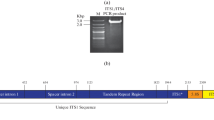Abstract
The archiascomycetous fungus Protomyces pachydermus has two group I introns within the nuclear small subunit (nSSU) rRNA gene. One of these introns has an internal open reading frame (ORF) that encodes a predicted protein of 228 amino acid residues. On the other hand, Protomyces macrosporus has two group I introns that insert at the same positions as P. pachydermus, which have no ORF. Each alignment was constructed with Protomyces group I introns located in the same position and other introns retrieved by the BLAST Search. Each phylogenetic tree based on the alignment shows that Protomyces introns are monophyletic but the relationships among fungal introns do not reflect on the fungal phylogeny. Therefore, it is suggested that two different horizontal transfers of group I introns occurred at the early stage of Protomyces species diversification.
Similar content being viewed by others
References
Altschul SF, Gish W, Miller W, Myers EW, Lipman DJ (1990) Basic local alignment search tool. J Mol Biol 215:403–410
Belfort M, Perlman PS (1995) Mechanisms of intron mobility. J Biol Chem 270:30237–30240
Berbee ML (1996) Loculoascomycete origins and evolution of filamentous ascomycete morphology based on 18S rRNA gene sequence data. Mol Biol Evol 13:462–470
Berbee ML, Taylor JW (1993) Dating the evolutionary radiations of the true fungi. Can J Bot 71:1114–1127
Bhattacharya D, Surek B, Rüsing M, Damberger S, Melkonian M (1994) Group I introns are inherited through common ancestry in the nuclear-encoded rRNA of Zygnematales (Charophyceae). Proc Natl Acad Sci USA 91:9916–9920
Bhattacharya D, Friedl T, Damberger S (1996) Nuclear-encoded rRNA group I introns: origin and phylogenetic relationships of insertion site lineages in the green algae. Mol Biol Evol 13:978–989
Cech TR (1988) Conserved sequences and structures of group I introns: building an active site for RNA catalysis—a review. Gene 73:259–271
Cech TR (1990) Self-splicing of group I introns. Annu Rev Biochem 59:543–568
De Jonckheere JF (1994) Evidence for the ancestral origin of group I introns in the SSU rDNA of Naegleria spp. J Euk Microbiol 41: 457–463
Dujon B (1989) Group I introns as mobile genetic elements: facts and mechanistic speculations—a review. Gene 82:91–114
Gargas A, DePriest PT, Taylor JW (1995) Positions of multiple inser- tions in SSU rDNA of lichen-forming fungi. Mol Biol Evol 12: 208–218
Hibbett DS (1996) Phylogenetic evidence for horizontal transmission of group I introns in the nuclear ribosomal DNA of mushroom-forming fungi. Mol Biol Evol 13:903–917
Johansen S, Vogt VM (1994) An intron in the nuclear ribosomal DNA of Didymium iridis codes for a group I ribozyme and a novel ribozyme that cooperate in self-splicing. Cell 76:725–734
Lambowitz AM, Beifort M (1993) Introns as mobile genetic elements. Annu Rev Biochem 62:587–622
Michel F, Westhof E (1990) Modelling of the three-dimensional architecture of group I catalytic introns based on comparative sequence analysis. J Mol Biol 216:585–610
Mota EM, Collins RA (1988) Independent evolution of structural and coding regions in a Neurospora mitochondrial intron. Nature 332: 654–656
Nishida H, Sugiyama J (1994) Archiascomycetes: detection of a major new lineage within the Ascomycota. Mycoscience 35:361–366
Nishida H, Sugiyama J (1995) A common group I intron between a plant parasitic fungus and its host. Mol Biol Evol 12:883–886
Nishida H, Blanz PA, Sugiyama J (1993) The higher fungus Protomy-ces inouyei has two group I introns in the 18S rRNA gene. J Mol Evol 37:25–28
Oliveira MC, Ragan MA (1994) Variant forms of a group I intron in nuclear small-subunit rRNA genes of the marine red alga Porphyra spiralis var. amplifolia. Mol Biol Evol 11:195–207
Ruoff B, Johansen S, Vogt VM (1992) Characterization of the self- splicing products of a mobile intron from the nuclear rDNA of Physarum polycephalum. Nucleic Acids Res 20:5899–5906
Saitou N, Nei M (1987) The neighbor-joining method: a new method for reconstructing phylogenetic trees. Mol Biol Evol 4:406–425
Sjamsuridzal W, Tajiri Y, Nishida H, Thuan TB, Kawasaki H, Hirata A, Yokota A, Sugiyama J (1997) Evolutionary relationships of members of the genera Taphrina, Protomyces, Schizosaccharomyces, and related taxa within the archiascomycetes: integrated analysis of genotypic and phenotypic characters. Mycoscience 38:267–280
Thompson JD, Higgins DG, Gibson TJ (1994) CLUSTAL W: improving the sensitivity of progressive multiple sequence alignment through sequence weighting, positions-specific gap penalties and weight matrix choice. Nucleic Acids Res 22:4673–1680
Vader A, Naess J, Haugli K, Haugli F, Johansen S (1994) Nucleolar introns from Physarum flavicomum contain insertion elements that may explain how mobile group I introns gained their open reading frames. Nucleic Acids Res 22:4553–559
Vaughn JC, Mason MT, Sper-Whitis GL, Kuhlman P, Palmer JD (1995) Fungal origin by horizontal transfer of plant mitochondrial group I intron in the chimeric cox I gene of Peperomia. J Mol Evol 41:563–572
Author information
Authors and Affiliations
Rights and permissions
About this article
Cite this article
Nishida, H., Tajiri, Y. & Sugiyama, J. Multiple origins of fungal group I introns located in the same position of nuclear SSU rRNA gene. J Mol Evol 46, 442–448 (1998). https://doi.org/10.1007/PL00006324
Received:
Accepted:
Issue Date:
DOI: https://doi.org/10.1007/PL00006324




